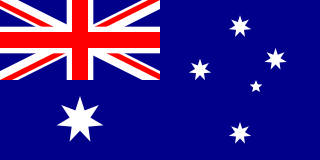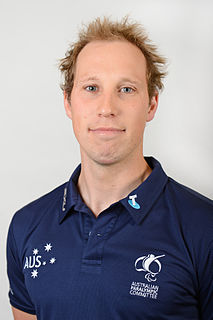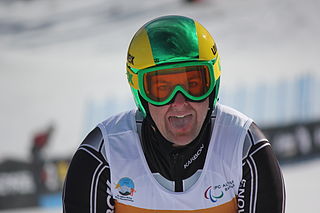
Australia has competed in every Winter Paralympics. In 1976, the first Games, Australia's sole competitor was Ron Finneran, but he was not an official entrant. In 1980, Kyrra Grunnsund and Peter Rickards became the first official competitors, in alpine and cross-country skiing. The number of Australian athletes increased to three, five, five and six at the next four games, respectively, and all of the athletes were alpine skiers. The participation decreased to four in 1998 and climbed back up to six in 2002. Australia won its first Winter Paralympic medals in 1992, and has medalled at every games since then. All of the medals have been won in alpine skiing.

Michael John Milton, OAM is an Australian Paralympic skier, Paralympic cyclist and paratriathlete with one leg. With 6 gold, 3 silver and 2 bronze medals he is the most successful Australian Paralympic athlete in the Winter Games.

Toby Kane is an Australian Paralympian who won a bronze medal in the men's super G Standing at the 2006 Winter Paralympics in Torino and a bronze medal in the men's super G standing in his third Winter Paralympics at the 2014 Winter Paralympics in Sochi. Invited to join the Australian Winter Paralympic Development team when he was just 11, he became the youngest member of the Australian team in Torino at the age of 19. He had the honour of being Australia's flag bearer at the closing ceremony in Torino, and at the opening ceremony in Vancouver. Towards the end of the Sochi Games, Kane and Dutch snowboarder Bibian Mentel-Spee were named winners of the Whang Youn Dai Achievement Award, which is presented at every Paralympic Games for outstanding performances and overcoming adversity.
Matthew Stockford is a British former Paralympic skier who won medals at the 1992 Winter Paralympics and 1994 Winter Paralympics. Stockford broke his back in a skiing accident in 1985. He competed using a monoski – a specially fitted chair over a single ski that includes seat belts and other strapping, as well as a suspension device to minimise wear and tear on the skier's body.

The 1998 Winter Paralympics were held in Nagano, Japan from the 5–14 March 1998. At the Games, Australia was represented by four male alpine skiers. Australia finished equal 16th of 21 Nations on the overall medal tally. James Patterson, an LW9 standing skier, won Australia's two medals - one gold and one bronze.

Australia competed at the 1992 Winter Paralympics in Tignes and Albertville in France. They were the first winter Paralympics to be celebrated concurrently with the Olympic Games. The official logo of the Games was designed by Jean-Michel Folon.It depicts a bird with broken wings, soaring high across the peak of a mountain. This was used to reflect the sporting abilities of the athletes at the Games. The official mascot, Alpy, designed by Vincent Thiebaut, represented the summit of the Grande Motte mountain in Tignes. Alpy was shown on a mono-ski to demonstrate its athleticism and the colours of white, green and blue were used to represent purity/snow, hope/nature and discipline/the lake. The 1992 Games were where Australia won their first winter medals at the Paralympics. Michael Milton won Australia's first gold with a win in the Men's Slalom LW2. Milton also won a silver medal in the Men's Super G LW2. At these Games, Australia was represented by 5 male athletes. Australia was placed 12th in the overall medal tally for the Winter Games winning a total of 4 medals: 1 gold, 1 silver and 2 bronze.

The 1994 Winter Paralympics were held in Lillehammer, Norway. Australia sent six male skiers, who won three gold, two silver and four bronze medals. Australia, at the time, achieved their best ever performance at a Winter Paralympics, finishing 5th overall in the alpine skiing competition, 9th in the medal standings, and 11th in the total medal count out of 31 nations.

Cameron Rahles-Rahbula was a Paralympic alpine skier from Australia. He won two bronze medals at the 2010 Winter Paralympics in Vancouver. He represented Australia in four Paralympics, stating with the 2002 Winter Paralympics in Salt Lake City and the 2006 Winter Paralympics in Torino. He did not compete in any events at the 2014 Winter Paralympics in Sochi due to knee and ankle injuries suffered during the warm up for the downhill event of the Games but carried the Australian flag in the Parade of Nations at the Opening Ceremony. He also won two gold medals and a silver medal at the 2004 IPC Alpine Skiing World Championships in Wildschönau, Austria, and a gold and a bronze medal at the 2009 World Championships in Jeongseon, Korea. He retired after the Sochi Games.
LW12 is a para-Alpine and para-Nordic sit skiing sport class defined by the International Paralympic Committee (IPC). An LW12 skier needs to meet a minimum of one of several conditions including a single below knee but above ankle amputation, monoplegia that exhibits similar to below knee amputation, legs of different length where there is at least a 7 centimetres difference, combined muscle strength in the lower extremities less than 71. For international competitions, classification is done through IPC Alpine Skiing or IPC Nordic Skiing. For sub-international competitions, classification is done by a national federation such as Alpine Canada. For para-Alpine, this class is subdivided into two subclasses.: LW12.1 and LW12.2. A new sit-skier competitor with only national classification will compete as LW12.2 in international competitions until they have been internationally classified.

LW10 is a para-Alpine and para-Nordic sit-skiing classification for skiers who cannot sit up without support. For international skiing competitions, classification is conducted by International Paralympic Committee (IPC) Alpine Skiing and IPC Nordic Skiing, while national federations such as Alpine Canada handle classification for domestic competitions.

LW1 is a para-Alpine standing skiing classification for people with severe lower extreme disabilities in both extremities. It includes both skiers with amputations and cerebral palsy. International classification is done through International Paralympic Committee Alpine Skiing, and national classification through local national sport federations. LW1 classified skiers use outriggers, and two skis or one ski with a prosthesis. Other equipment is used during training such as ski-tips, ski-bras, and short skis.

LW2 is a para-Alpine and para-Nordic standing ski sport class defined by the International Paralympic Committee (IPC). Competitors in this class have severe disability in a lower limb, which may be a result of an amputation, or arthrodesis in the leg and hip. Depending on the type of skiing, the international classification process for LW2 skiers is handled by the IPC Alpine Skiing Technical Committee and IPC Nordic Skiing Technical Committee. National sport federations handle classification on the lower levels.
LW3 is a para-Alpine and para-Nordic standing skiing sport class defined by the International Paralympic Committee (IPC) for skiers with a disability affecting both legs, with double below knee amputation or a combined strength total for both legs of 60, with 80 as the baseline for people without disabilities. For international skiing competitions, classification is done through IPC Alpine Skiing or IPC Nordic Skiing. The classification has two subclasses for para-Alpine skiing: LW3.1 which is for people with double below the knee amputations or similar disabilities, and LW3.2 which is for people with cerebral palsy that involves moderate athetoid, moderate ataxic impairment or slight diplegic involvement.
LW5/7 is a standing para-Alpine and para-Nordic skiing classification for skiers with upper extremity issues in both limbs that may include double amputation of both arms and hands or dysmelia of the upper limbs. The class has three subclasses defined by the location of the disability on the upper extremities. International classification is done by IPC Alpine Skiing and IPC Nordic Skiing. On the national level, classification is handled by national sports federation such as Cross-Country Canada.

LW6/8 is a para-Alpine and para-Nordic standing skiing sport class, a classification defined by the International Paralympic Committee (IPC) for people with an upper extremity issue who have paralysis, motor paresis affecting one arm, a single upper arm amputation or CP8 classified cerebral palsy. LW6/8 skiers use two skis and one pole in both para-Alpine and para-Nordic skiing.
LW9 is a para-Alpine and para-Nordic standing skiing sport class, a classification defined by the International Paralympic Committee (IPC) for people with upper and lower limb function problems, and includes cerebral palsy skiers classified CP5, CP6 and CP7, along with people with hemiplegia or amputations. For international skiing competitions, classification is done through IPC Alpine Skiing or IPC Nordic Skiing. A national federation such as Alpine Canada handles classification for domestic competitions. This classification is separated into two subclasses including LW9.1 and LW9.2.

Mitchell Gourley is an Australian Paralympic alpine skier who competed for Australia in the downhill, super-G, giant slalom, slalom and super combined events at the 2010 Winter Paralympics in Vancouver and 2014 Winter Paralympics in Sochi, but did not win a medal. At the 2017 IPC Alpine Skiing World Championships in Tarvisio, Italy he won the gold medal in the Men's Super Combined Standing. He was Australian team co-captain at the 2018 Winter Paralympics.
Karolina Wisniewska is a para-alpine standing skier. Born in Warsaw, she moved to Canada when she was 5 years old where she then took up skiing as a form of physical therapy for her cerebral palsy. Over the course of her skiing career, she won eight total Paralympic medals for skiing, and 18 medals at International Paralympic Committee (IPC) World Cups. At the 2002 Winter Paralympics, she earned four medals, the most ever earned by a Canadian para-alpine skier at a single Games. Wisniewska retired from the sport for a second time in May 2012 following an injury in 2011 that resulted in her missing most of the 2011/2012 skiing season.

Alexey Sergeyevich Bugaev is a Russian para-alpine skier who competed at the 2014 Winter Paralympics, winning five medals.

















